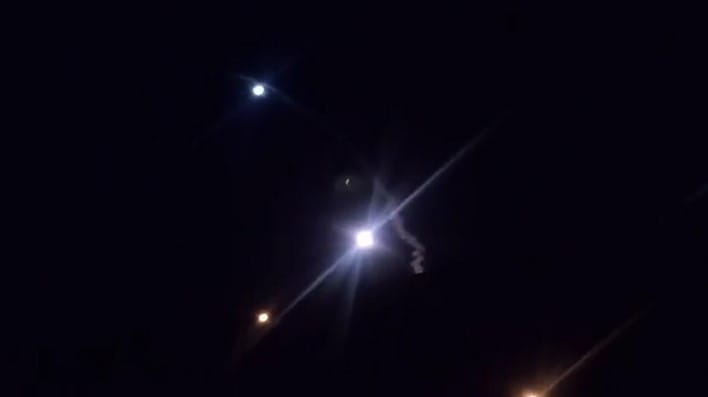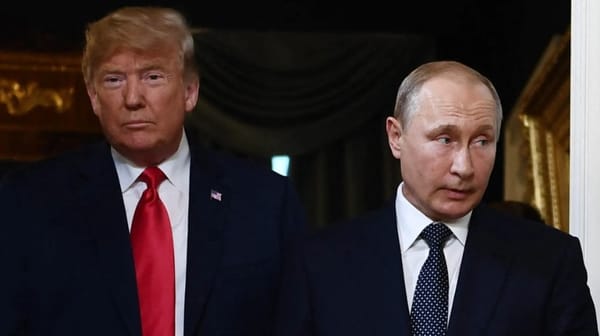Iran Launches Retaliatory Missile Strikes Against U.S. Military Bases

Executive Summary
On Monday, June 23, 2025, Iran launched a coordinated missile attack against U.S. military installations in Qatar and Iraq, marking a significant escalation in Middle Eastern tensions following the United States' unprecedented strikes on Iranian nuclear facilities over the weekend [1][2][3]. The Iranian Revolutionary Guard Corps (IRGC) targeted Al Udeid Air Base in Qatar, the largest U.S. military installation in the Middle East, with what Tehran described as "devastating and powerful missiles" under an operation dubbed "Blessings of Victory" [1:1][4][5].
The missile strikes represent Iran's direct retaliation against the United States for "Operation Midnight Hammer," a massive American bombing campaign that targeted three key Iranian nuclear sites—Fordow, Natanz, and Isfahan—on June 21-22, 2025 [6][7][8]. This escalation transforms what began as an Israel-Iran conflict into a broader confrontation involving the world's most powerful military and the Middle East's most influential regional power.
Qatar's air defense systems successfully intercepted the incoming Iranian missiles, with no casualties reported at Al Udeid Air Base, though the attack constitutes a grave violation of Qatari sovereignty and international law [9][10][11]. Approximately 10,000 U.S. troops stationed at the base were ordered to shelter in place as explosions echoed across the Qatari capital of Doha [1:2][12][13].
Background: The Israel-Iran War and U.S. Entry
Origins of the Conflict
The current crisis began on June 13, 2025, when Israel launched a surprise offensive against numerous Iranian nuclear and military objectives [14][15][16]. Israeli Prime Minister Benjamin Netanyahu claimed the operation aimed to dismantle Iran's nuclear program, asserting that Tehran was approaching the capability to produce nuclear weapons [14:1][8:1]. Iran maintains that its nuclear endeavors are exclusively peaceful, a position supported by the International Atomic Energy Agency (IAEA) [8:2][17].
The initial Israeli strikes resulted in devastating casualties, with Iranian health authorities reporting over 800 deaths and more than 3,000 wounded by June 22, according to the Washington-based Human Rights Activists News Agency (HRANA) [16:1][13:1]. High-ranking Iranian military officials, including Armed Forces Chief of Staff Major General Mohammad Bagheri and IRGC Commander Hossein Salami, were among those killed in the opening strikes [16:2].
U.S. Decision to Intervene
President Donald Trump's decision to directly intervene in the Israel-Iran conflict marked a dramatic escalation that drew the United States into what many experts warned could become a prolonged regional war [14:2][18][19]. Trump had previously indicated he would take up to two weeks to determine whether the U.S. should intervene on Israel's behalf, but the timeline accelerated as the conflict intensified [15:1].
The American president proceeded without congressional approval, a decision that has sparked significant constitutional debate [18:1][20][21]. While Republican leaders largely supported the action, many Democrats and some Republicans argued that Trump lacked the authority to conduct such military operations without congressional authorization [20:1][22][23].
Operation Midnight Hammer: The U.S. Strike on Iran
Mission Details and Execution
Operation Midnight Hammer represented the largest B-2 operational strike in U.S. history, involving seven B-2 Spirit stealth bombers, 125 total aircraft, and more than 75 precision-guided weapons [6:1][7:1][24]. The mission commenced at midnight on June 21, 2025, with the B-2 bombers departing from their base in Missouri for an 18-hour flight requiring multiple in-flight refuelings [6:2][8:3].
The operation targeted three critical Iranian nuclear facilities:
Fordow Uranium Enrichment Plant: A heavily fortified underground facility located approximately 48 kilometers from Qom, buried 300 feet within mountainous terrain [8:4][24:1][25]. The site was struck with 14 GBU-57A/B Massive Ordnance Penetrator (MOP) bombs, each weighing 30,000 pounds and capable of penetrating 200 feet underground [7:2][26][27].
Natanz Nuclear Facility: Iran's largest uranium enrichment complex, situated near Isfahan in central Iran [8:5][24:2][25:1]. The facility was targeted with precision-guided munitions, causing severe damage to both above-ground and underground components [24:3][17:1][27:1].
Isfahan Nuclear Technology Center: A crucial research and conversion facility located south of Isfahan city [8:6][24:4][25:2]. The site was struck with over two dozen Tomahawk missiles launched from U.S. submarines [6:3][17:2][27:2].
Immediate Results and Damage Assessment
Initial battle damage assessments indicated that all three sites "sustained extremely severe damage and destruction," according to General Dan Caine, Chairman of the Joint Chiefs of Staff [6:4][24:5][27:3]. Satellite imagery revealed significant impact craters at Fordow, with six evenly spaced penetrations visible in the mountainside [27:4][28]. At Natanz, a 5.5-meter diameter crater was observed directly over the underground facility [27:5].
The International Atomic Energy Agency (IAEA) reported no increase in off-site radiation levels following the strikes, suggesting that Iran may have evacuated nuclear materials prior to the attacks [17:3][29][27:6]. IAEA Director Rafael Grossi estimated the damage to be "very significant," particularly at Fordow, due to the sensitivity of centrifuges to vibrations caused by the massive explosions [17:4].
Iran's Retaliatory Response
Planning and Execution of the Missile Strikes
Iran's retaliation came swiftly, with the Islamic Revolutionary Guard Corps launching what it termed "Operation Besharat Fatah" (Blessings of Victory) on Monday evening, June 23, 2025 [5:1][11:1][30]. The operation represented a calculated response designed to demonstrate Iran's capability to strike U.S. forces while avoiding civilian casualties that could trigger a more devastating American response.
According to multiple sources, Iran launched at least 10 missiles toward U.S. bases in Qatar and at least one missile toward Iraq [3:1][4:1][9:1]. The primary target was Al Udeid Air Base in Qatar, which serves as the forward headquarters for U.S. Central Command and hosts approximately 10,000 American military personnel [1:3][12:1][5:2].
Operational Details
The Iranian missile strikes occurred shortly after Qatar announced the temporary closure of its airspace due to rising regional tensions [9:2][31][32]. Witnesses in Doha reported seeing missiles in the skies above the capital, followed by the activation of air defense systems [4:2][12:2][13:2].
Iran's Supreme National Security Council stated that the number of missiles used in the operation equaled the number of bombs the United States had deployed against Iranian nuclear facilities, suggesting a proportional response strategy [5:3]. The missiles were deliberately targeted at military installations located far from civilian populations to minimize collateral damage [5:4][11:2].
Qatar's Response and Casualties
Qatar's Ministry of Defense confirmed that its air defense systems successfully intercepted the Iranian missiles, preventing any casualties at Al Udeid Air Base [9:3][10:1][11:3]. However, the Qatari government strongly condemned the attack as "a flagrant violation of the sovereignty of the State of Qatar, its airspace, international law, and the United Nations Charter" [1:4][11:4].
The Qatari Ministry of Foreign Affairs reserved the right to respond directly to what it characterized as "brazen aggression," while emphasizing that Qatar had not sought involvement in the conflict between Iran and other regional powers [1:5][11:5].
Strategic Implications and Analysis
Military Significance
The Iranian missile attack on Al Udeid Air Base represents a significant escalation in the conflict, marking the first direct Iranian strike against U.S. military facilities since the 2020 retaliation for the assassination of Quds Force Commander Qasem Soleimani [3:2][26:1]. The attack demonstrates Iran's willingness to directly confront U.S. forces rather than rely solely on proxy groups, as it has done in previous conflicts.
The successful interception of Iranian missiles by Qatari air defense systems highlights the effectiveness of advanced missile defense technologies deployed throughout the region [9:4][10:2][33]. However, the attack also exposes the vulnerability of U.S. bases in the Middle East to Iranian missile capabilities, which have been significantly enhanced in recent years.
Regional Security Dynamics
The missile strikes have fundamentally altered the security landscape in the Persian Gulf region, transforming what began as an Israel-Iran confrontation into a broader conflict involving the United States [9:5][34][35]. The attack on Al Udeid Air Base particularly concerns regional allies, as it demonstrates Iran's capability and willingness to target critical infrastructure in neighboring countries.
Several regional powers have expressed alarm at the escalation. Saudi Arabia voiced "deep concern" over the U.S. strikes on Iran and called for restraint and de-escalation [36]. The United Arab Emirates, which hosts U.S. military personnel at Al Dhafra Air Base, has likely increased security measures in response to the heightened threat environment [37].
International Diplomatic Reactions
The international community has responded with a mixture of concern and condemnation to the escalating conflict. The United Nations Secretary-General António Guterres expressed grave alarm at the strikes, calling for de-escalation and warning of a potential "spiral of chaos" [36:1]. China strongly condemned the U.S. strikes, characterizing them as a violation of international law and U.N. Charter principles [36:2][38].
European nations have generally supported the goal of preventing Iranian nuclear weapons development while calling for diplomatic solutions. The European Commission President Ursula von der Leyen emphasized that "the negotiating table is the only place to end this crisis" [36:3]. France, while reiterating its opposition to Iranian nuclear weapons, urged both parties to exercise restraint and pursue negotiated solutions [36:4].
Congressional and Constitutional Implications
Legislative Response
President Trump's decision to authorize strikes against Iranian nuclear facilities without congressional approval has triggered significant debate about executive war powers and constitutional limitations [20:2][22:1][21:1]. The U.S. Constitution grants Congress the exclusive authority to declare war, while designating the president as commander-in-chief of the armed forces [21:2][23:1].
House Speaker Mike Johnson and Senate Majority Leader John Thune supported Trump's action, arguing that the imminent threat justified the president's decision to act without waiting for congressional authorization [39][20:3]. Johnson stated that "the Commander-in-Chief evaluated that the imminent danger outweighed the time it would take for Congress to act" [39:1].
Bipartisan Criticism
However, the military action has faced bipartisan criticism from lawmakers who argue that Trump exceeded his constitutional authority. Republican Representative Thomas Massie of Kentucky and Democratic Representative Ro Khanna of California have introduced legislation to prohibit further U.S. military involvement in Iran without congressional approval [22:2][23:2].
Democratic Senator Tim Kaine of Virginia has proposed legislation that would require Trump to cease military actions against Iran unless explicitly authorized by Congress [23:3]. "This is the U.S. entering a conflict of choice at the behest of Donald Trump, without any pressing national security justification," Kaine stated [23:4].
Constitutional Precedents
The current situation presents a new test of the balance between executive and legislative war powers, particularly in the context of the 1973 War Powers Resolution [21:3]. Legal scholars remain divided on whether Trump's actions fall within his Article II powers or constitute an unauthorized act of war requiring congressional approval [21:4][40].
Economic and Energy Market Implications
Oil Market Volatility
The escalating conflict has generated significant volatility in global energy markets, with oil prices initially surging over 2% following the U.S. strikes on Iranian nuclear facilities [41]. Brent crude prices reached $78.81 per barrel, while U.S. crude climbed to $75.60 per barrel in immediate response to the military action [41:1].
The primary concern for energy markets centers on the potential for Iran to threaten closure of the Strait of Hormuz, through which approximately 20% of global oil consumption passes daily [41:2][42]. Such an action would constitute Iran's most significant economic retaliation option and could trigger a global energy crisis.
Regional Economic Impact
The conflict has already begun affecting regional economic stability, with several Gulf states implementing enhanced security measures that could impact normal commercial operations [43][35:1]. Qatar's temporary closure of its airspace demonstrates how quickly regional conflicts can disrupt international travel and commerce [31:1][13:3].
The targeting of Al Udeid Air Base, which serves as a critical hub for U.S. military operations in the region, raises concerns about the security of other infrastructure vital to regional economic stability [5:5][33:1]. Energy facilities in Saudi Arabia, the UAE, and other Gulf states remain potential targets for Iranian retaliation [42:1][37:1].
Military Capabilities and Force Posture
U.S. Military Presence in the Region
The United States maintains a substantial military presence throughout the Middle East, with tens of thousands of troops stationed across multiple countries [26:2][33:2][37:2]. Key installations include:
- Al Udeid Air Base, Qatar: The largest U.S. military installation in the Middle East, hosting approximately 10,000 personnel and serving as CENTCOM's forward headquarters [1:6][5:6][33:3]
- Al Asad Air Base, Iraq: A major facility housing thousands of U.S. service members and representing the largest American deployment in Iraq [44][37:3]
- Al Dhafra Air Base, UAE: Home to the 380th Air Expeditionary Wing, including F-22 Raptor fighters and various surveillance aircraft [37:4]
- Ali al-Salem Air Base, Kuwait: Hosts personnel from the 386th Air Expeditionary Wing [37:5]
- Naval Forces: Two carrier strike groups currently deployed in the Arabian Sea [33:4]
Iran's Military Capabilities
Iran has developed sophisticated military capabilities specifically designed to counter U.S. forces in the region [44:1][42:2]. These include:
- Ballistic Missile Arsenal: Iran possesses hundreds of ballistic missiles capable of reaching U.S. bases throughout the region [9:6][42:3]
- Proxy Network: The "Axis of Resistance" includes allied militias in Iraq, Syria, and Yemen, though this network has been significantly degraded by recent conflicts [44:2][42:4]
- Asymmetric Warfare Capabilities: Iran has invested heavily in drone technology, coastal defense systems, and guerrilla warfare tactics [44:3][42:5]
Defensive Measures
U.S. forces in the region are protected by multiple layers of defense systems, including Patriot surface-to-air missile batteries and Terminal High Altitude Area Defense (THAAD) systems [33:5]. However, the proximity of Iranian missiles and the limited warning time available for defense present ongoing challenges [42:6].
Regional Proxy Dynamics
Iranian Proxy Groups
Iran's extensive network of proxy groups across the Middle East represents a significant component of its military strategy, though recent conflicts have substantially weakened these capabilities [44:4][42:7]. Key proxy groups include:
- Hezbollah (Lebanon): Severely damaged by Israeli operations in 2024, with most of its leadership eliminated [42:8]
- Houthi Movement (Yemen): Remains capable of maritime attacks in the Red Sea and missile strikes against regional targets [42:9]
- Iraqi Militias: Various groups operating under the Islamic Resistance in Iraq umbrella continue to pose threats to U.S. forces [44:5]
Proxy Threat Assessment
While Iran's proxy network has been significantly degraded, remaining groups retain capabilities that could complicate U.S. operations in the region [42:10]. The Houthis have threatened to resume Red Sea attacks if the U.S. enters the war, while Iraqi militias have already conducted limited attacks against U.S. bases [44:6].
The activation of these proxy groups represents one of Iran's most significant retaliatory options, as it allows Tehran to maintain pressure on U.S. forces while preserving plausible deniability [44:7][42:11].
Intelligence and Assessment Challenges
Damage Assessment Complexities
Determining the actual impact of both U.S. strikes on Iranian nuclear facilities and Iranian missile attacks on U.S. bases presents significant intelligence challenges [24:6][17:5][28:1]. The underground nature of Iran's nuclear facilities makes comprehensive damage assessment particularly difficult, requiring specialized intelligence collection capabilities.
Satellite imagery provides some insights into surface damage, but the extent of underground destruction at facilities like Fordow remains uncertain [27:7][28:2]. The IAEA has limited access to conduct independent assessments, further complicating efforts to determine the effectiveness of the U.S. strikes [17:6].
Iranian Operational Security
Iran's apparent advance warning of the U.S. strikes, evidenced by the lack of radioactive material releases and minimal casualties, suggests effective intelligence and operational security measures [29:1][25:3]. Iranian officials likely relocated critical nuclear materials and personnel prior to the attacks, limiting the strategic impact of the U.S. bombing campaign.
This operational security extends to Iran's missile strike planning, with the coordinated nature of the attacks indicating sophisticated command and control capabilities [9:7][5:7]. The precise timing and targeting of the Iranian retaliation demonstrate advanced military planning and execution capabilities.
Diplomatic Efforts and Peace Prospects
International Mediation Attempts
Despite the military escalation, diplomatic efforts continue to seek a peaceful resolution to the conflict [36:5][38:1]. Several countries and international organizations have called for immediate de-escalation and a return to diplomatic negotiations.
The European Union has emphasized the importance of dialogue, with Commission President von der Leyen stating that "the negotiating table is the only place to end this crisis" [36:6]. China has similarly called for dialogue and negotiation, while condemning the military escalation [36:7].
Regional Diplomatic Initiatives
Regional powers have begun exploring diplomatic solutions to prevent further escalation [36:8][38:2]. Saudi Arabia has called for international community efforts to reach a political resolution, while maintaining its position that Iran should not possess nuclear weapons [36:9].
The involvement of Russia in potential mediation efforts, including reported meetings between Iranian Foreign Minister Abbas Araghchi and Russian President Vladimir Putin, adds another dimension to the diplomatic landscape [45][43:1].
Obstacles to Diplomacy
Several factors complicate diplomatic efforts to resolve the crisis:
- Mutual Escalation: Both sides have invested significant military resources and political capital in the conflict
- Domestic Political Pressures: Leaders face internal pressure to maintain strong positions
- Regional Dynamics: The involvement of multiple regional actors complicates bilateral negotiations
- Nuclear Program Disputes: Fundamental disagreements over Iran's nuclear program remain unresolved
Humanitarian Implications
Civilian Casualties and Displacement
The conflict has resulted in significant civilian casualties, particularly in Iran, where Israeli strikes have killed hundreds of civilians according to various reports [16:3][13:4]. The Iranian health ministry has reported over 2,500 wounded, with many requiring ongoing medical care [16:4].
In Israel, Iranian missile strikes have killed at least 24 civilians and wounded nearly 600 others, according to CNN reporting [16:5][9:8]. The psychological impact on civilian populations in both countries has been substantial, with many seeking shelter during missile alerts.
Refugee and Displacement Concerns
The escalating conflict raises concerns about potential refugee flows and internal displacement [35:2]. While the current conflict has not yet generated massive population movements, continued escalation could force civilian evacuations from border areas and major cities.
Regional humanitarian organizations have begun preparing for potential displacement scenarios, though the international community's capacity to respond remains limited given ongoing conflicts in other regions [35:3].
Infrastructure and Essential Services
The targeting of military and nuclear facilities has thus far avoided major civilian infrastructure, but the risk of broader targeting remains [29:2][25:4]. Iran's threats to close the Strait of Hormuz could significantly impact global supply chains and energy availability [41:3][42:12].
Future Scenarios and Strategic Outlook
Escalation Pathways
Several potential escalation pathways could emerge from the current crisis:
Expanded Military Engagement: Further U.S. strikes on Iranian targets could trigger broader Iranian retaliation, potentially including attacks on oil infrastructure or Israeli population centers [46][42:13].
Proxy Activation: Iran could activate remaining proxy groups to conduct sustained attacks against U.S. and Israeli interests throughout the region [44:8][42:14].
Maritime Warfare: Iranian threats to close the Strait of Hormuz could lead to naval confrontations with significant global economic implications [41:4][42:15].
Nuclear Escalation: Iran's decision to potentially withdraw from the Nuclear Non-Proliferation Treaty could accelerate nuclear weapons development [17:7].
De-escalation Possibilities
Potential paths to de-escalation include:
Diplomatic Engagement: Renewed negotiations facilitated by international mediators could address underlying nuclear program concerns [36:10][38:3].
Proportional Response: Iran's measured retaliation may indicate a preference for controlled escalation rather than all-out war [5:8][11:6].
Economic Pressure: International economic incentives could encourage both sides to seek peaceful solutions [41:5].
Long-term Strategic Implications
The current crisis is likely to have lasting implications for Middle Eastern security architecture:
- U.S.-Iran Relations: Direct military confrontation may fundamentally alter the relationship between the two countries
- Regional Security: Gulf states may accelerate defense cooperation and military modernization programs
- Nuclear Proliferation: The conflict could influence other regional powers' nuclear ambitions
- Alliance Structures: The crisis may reshape existing alliance relationships and create new security partnerships
Technology and Warfare Evolution
Advanced Weapons Systems
The conflict has showcased several advanced military technologies, including the first operational use of the GBU-57 Massive Ordnance Penetrator (MOP) bunker-buster bombs [27:8]. These 30,000-pound weapons represent the pinnacle of deep underground target engagement capabilities, designed specifically for facilities like Iran's Fordow complex [26:3][24:7].
Iran's missile capabilities have also been demonstrated, with the successful launch of multiple ballistic missiles capable of reaching targets throughout the region [9:9][5:9]. The precision and coordination of these strikes indicate significant advances in Iranian missile technology and command systems.
Defense System Performance
The successful interception of Iranian missiles by Qatari air defense systems demonstrates the effectiveness of modern missile defense technologies [9:10][10:3]. However, the attacks also highlight the challenges of defending against saturation attacks and the importance of layered defense systems.
The integration of various defense platforms, including Patriot systems, THAAD batteries, and naval-based interceptors, provides comprehensive coverage but requires significant resources and coordination [33:6].
Intelligence and Surveillance
Both sides have demonstrated sophisticated intelligence capabilities, with Iran apparently receiving advance warning of U.S. strikes and the U.S. conducting complex surveillance operations to target Iranian facilities [29:3][25:5]. The role of satellite imagery and electronic intelligence in both offensive and defensive operations has been crucial [27:9][28:3].
Media and Information Warfare
Propaganda and Messaging
Both sides have engaged in extensive information warfare, with Iran characterizing its missile strikes as a "mighty and successful response" while the U.S. has emphasized the precision and effectiveness of its nuclear facility attacks [30:1][19:1]. State media in both countries has played a significant role in shaping public perception and international opinion.
Iranian state television's coverage of the missile strikes, complete with martial music and patriotic messaging, demonstrates the importance of domestic audience considerations in military planning [30:2]. Similarly, U.S. officials have emphasized the success of Operation Midnight Hammer while minimizing the impact of Iranian retaliation.
International Media Coverage
Global media coverage has varied significantly, with different outlets emphasizing different aspects of the conflict based on their geopolitical perspectives [9:11][36:11]. The challenge of independent verification in an active conflict zone has complicated accurate reporting of casualties and damage assessments.
Social media has played an increasingly important role in information dissemination, with both official sources and civilian witnesses sharing real-time updates and imagery [4:3][13:5]. The verification of such content remains a significant challenge for news organizations and intelligence agencies.
Conclusion
The Iranian missile strikes against U.S. military bases on June 23, 2025, represent a watershed moment in Middle Eastern geopolitics, transforming a bilateral Israel-Iran conflict into a direct confrontation between Iran and the United States [1:7][2:1][3:3]. The successful interception of Iranian missiles by Qatari air defenses prevented casualties but demonstrated Iran's willingness to directly challenge American military presence in the region [9:12][10:4][11:7].
The escalation follows the unprecedented U.S. bombing of Iranian nuclear facilities in Operation Midnight Hammer, marking America's first direct military intervention in the Israel-Iran war [6:5][7:3][19:2]. While President Trump claimed the strikes "completely obliterated" Iran's nuclear capabilities, the long-term effectiveness of the operation remains uncertain, with Iran maintaining that its nuclear program will continue [14:3][29:4][25:6].
The crisis presents significant challenges for international diplomacy, congressional oversight, and regional stability [20:4][36:12][35:4]. The constitutional questions raised by Trump's decision to conduct military operations without congressional approval reflect broader concerns about executive war powers in an era of rapid military escalation [22:3][21:5][23:5].
Economic implications extend beyond the immediate region, with energy markets responding to the threat of Strait of Hormuz closure and broader Middle Eastern instability [41:6][42:16]. The involvement of regional allies and proxy groups adds additional complexity to an already volatile situation [44:9][42:17].
As the international community watches anxiously, the next phase of this conflict will likely determine whether the current escalation leads to broader regional war or provides an opportunity for diplomatic intervention [36:13][38:4]. The measured nature of Iran's retaliation, combined with the absence of casualties in the Al Udeid attack, may offer a narrow window for de-escalation efforts [5:10][11:8].
The events of June 23, 2025, will likely be remembered as a critical juncture in U.S.-Iran relations and Middle Eastern security dynamics, with implications extending far beyond the immediate participants to global stability and international law [1:8][9:13][36:14]. The world now awaits the next moves by all parties involved, hoping for restraint and diplomatic wisdom in the face of unprecedented regional tensions.
https://www.cbsnews.com/news/qatar-explosions-us-air-base-strikes-on-iran/ ↩︎ ↩︎ ↩︎ ↩︎ ↩︎ ↩︎ ↩︎ ↩︎ ↩︎
https://www.npr.org/2025/06/23/g-s1-74059/iran-attack-us-bases-iraq-qatar ↩︎ ↩︎
https://www.al-monitor.com/originals/2025/06/iran-retaliates-fires-missiles-us-bases-qatar-iraq ↩︎ ↩︎ ↩︎ ↩︎
https://www.middleeasteye.net/news/iran-launches-missiles-towards-us-bases-qatar-iraq ↩︎ ↩︎ ↩︎ ↩︎
https://www.ndtv.com/world-news/iran-strikes-al-udeid-base-in-qatar-operation-besharat-fatah-iran-attacks-us-air-base-what-we-know-so-far-8742828 ↩︎ ↩︎ ↩︎ ↩︎ ↩︎ ↩︎ ↩︎ ↩︎ ↩︎ ↩︎ ↩︎
https://www.cbsnews.com/news/pentagon-briefing-us-strikes-iran-nuclear-sites/ ↩︎ ↩︎ ↩︎ ↩︎ ↩︎ ↩︎
https://en.wikipedia.org/wiki/American_strikes_on_Iranian_nuclear_sites ↩︎ ↩︎ ↩︎ ↩︎
https://www.aljazeera.com/news/2025/6/22/satellite-images-show-damage-from-us-strikes-on-irans-fordow-nuclear-site ↩︎ ↩︎ ↩︎ ↩︎ ↩︎ ↩︎ ↩︎
https://www.cnn.com/world/live-news/israel-iran-us-strikes-06-23-25-intl-hnk ↩︎ ↩︎ ↩︎ ↩︎ ↩︎ ↩︎ ↩︎ ↩︎ ↩︎ ↩︎ ↩︎ ↩︎ ↩︎ ↩︎
https://www.bloomberg.com/news/articles/2025-06-23/iran-launches-missile-strike-at-us-air-base-in-qatar-tasnim ↩︎ ↩︎ ↩︎ ↩︎ ↩︎
https://www.ndtv.com/world-news/no-casualty-in-iranian-strikes-on-us-bases-reserve-right-to-respond-qatar-8742813 ↩︎ ↩︎ ↩︎ ↩︎ ↩︎ ↩︎ ↩︎ ↩︎ ↩︎
https://www.livenowfox.com/news/iran-attacks-al-udeid-air-base-qatar ↩︎ ↩︎ ↩︎
https://www.pbs.org/newshour/world/explosions-heard-in-qatar-home-to-u-s-airbase-amid-iranian-threats-to-retaliate-for-strike-on-nuclear-sites ↩︎ ↩︎ ↩︎ ↩︎ ↩︎ ↩︎
https://www.reuters.com/world/middle-east/iran-israel-launch-new-attacks-after-tehran-rules-out-nuclear-talks-2025-06-21/ ↩︎ ↩︎
https://en.wikipedia.org/wiki/Casualties_of_the_Iran–Israel_war ↩︎ ↩︎ ↩︎ ↩︎ ↩︎ ↩︎
https://www.aljazeera.com/news/2025/6/23/un-nuclear-chief-estimates-damage-to-irans-facilities-very-significant ↩︎ ↩︎ ↩︎ ↩︎ ↩︎ ↩︎ ↩︎ ↩︎
https://www.nytimes.com/live/2025/06/22/world/israel-iran-us-trump ↩︎ ↩︎
https://abcnews.go.com/Politics/us-hits-3-iranian-nuclear-sites-trump-plunging/story?id=123081409 ↩︎ ↩︎ ↩︎
https://www.nytimes.com/2025/06/21/world/middleeast/congress-iran-strike-republicans-democrats.html ↩︎ ↩︎ ↩︎ ↩︎ ↩︎
https://www.cnn.com/2025/06/23/politics/trump-iran-legal-constitutional-article-1-article-2 ↩︎ ↩︎ ↩︎ ↩︎ ↩︎ ↩︎
https://thehill.com/homenews/house/5363641-congress-iran-funding-bill/ ↩︎ ↩︎ ↩︎ ↩︎
https://www.reuters.com/world/us/us-lawmakers-call-congress-review-trumps-iran-actions-2025-06-22/ ↩︎ ↩︎ ↩︎ ↩︎ ↩︎ ↩︎
https://www.cfr.org/article/us-israel-attack-iranian-nuclear-targets-assessing-damage ↩︎ ↩︎ ↩︎ ↩︎ ↩︎ ↩︎ ↩︎ ↩︎
https://www.aljazeera.com/news/2025/6/22/how-far-will-us-strikes-set-back-irans-nuclear-programme ↩︎ ↩︎ ↩︎ ↩︎ ↩︎ ↩︎ ↩︎
https://www.nytimes.com/2025/06/21/us/politics/military-middle-east-wars.html ↩︎ ↩︎ ↩︎ ↩︎
https://www.cbsnews.com/news/satellite-photos-iran-fordo-nuclear-before-after-us-strikes/ ↩︎ ↩︎ ↩︎ ↩︎ ↩︎ ↩︎ ↩︎ ↩︎ ↩︎ ↩︎
https://www.reuters.com/world/middle-east/satellite-images-indicate-severe-damage-fordow-doubts-remain-2025-06-22/ ↩︎ ↩︎ ↩︎ ↩︎
https://apnews.com/article/israel-iran-war-nuclear-trump-bomber-news-06-22-2025-c2baca52babe915e033ae175ce8b2687 ↩︎ ↩︎ ↩︎ ↩︎ ↩︎
https://www.wnky.com/iran-says-it-launched-attack-on-us-forces-at-qatars-al-udeid-air-base/ ↩︎ ↩︎ ↩︎
https://www.axios.com/2025/06/23/iran-retaliation-trump-israel-war ↩︎ ↩︎
https://nypost.com/2025/06/23/world-news/iran-fires-missiles-toward-us-bases-in-qatar-and-iraq-reports/ ↩︎
https://www.businessinsider.com/iran-threatens-retaliation-us-has-firepower-ready-to-respond-2025-6 ↩︎ ↩︎ ↩︎ ↩︎ ↩︎ ↩︎ ↩︎
https://www.reuters.com/world/middle-east/israel-under-missile-attack-iran-says-all-options-open-after-us-strikes-2025-06-22/ ↩︎
https://www.globaltimes.cn/page/202506/1336803.shtml ↩︎ ↩︎ ↩︎ ↩︎ ↩︎
https://time.com/7296530/united-states-strikes-iran-world-leaders-react/ ↩︎ ↩︎ ↩︎ ↩︎ ↩︎ ↩︎ ↩︎ ↩︎ ↩︎ ↩︎ ↩︎ ↩︎ ↩︎ ↩︎ ↩︎
https://nypost.com/2025/06/21/world-news/here-are-some-of-the-us-bases-and-assets-iran-could-target/ ↩︎ ↩︎ ↩︎ ↩︎ ↩︎ ↩︎
https://www.reuters.com/world/americas/world-leaders-react-us-attack-iran-2025-06-22/ ↩︎ ↩︎ ↩︎ ↩︎ ↩︎
https://www.whitehouse.gov/articles/2025/06/what-they-are-saying-president-trumps-display-of-peace-through-strength/ ↩︎ ↩︎
https://theconversation.com/trumps-decision-to-bomb-iran-exposes-fissures-in-us-politics-259446 ↩︎
https://www.cnbc.com/2025/06/22/oil-prices-jump-after-us-strikes-on-iran-raise-fears-of-supply-disruption.html ↩︎ ↩︎ ↩︎ ↩︎ ↩︎ ↩︎ ↩︎
https://www.pbs.org/newshour/world/4-ways-tehran-could-retaliate-after-u-s-strikes-on-irans-nuclear-program ↩︎ ↩︎ ↩︎ ↩︎ ↩︎ ↩︎ ↩︎ ↩︎ ↩︎ ↩︎ ↩︎ ↩︎ ↩︎ ↩︎ ↩︎ ↩︎ ↩︎ ↩︎
https://www.newsweek.com/israel-pounds-tehran-strikes-fordow-again-khamenei-appeals-putin-2089251 ↩︎ ↩︎
https://www.fdd.org/analysis/policy_briefs/2025/06/16/u-s-forces-in-the-middle-east-under-attack-and-defending-israel/ ↩︎ ↩︎ ↩︎ ↩︎ ↩︎ ↩︎ ↩︎ ↩︎ ↩︎ ↩︎
https://www.nbcnews.com/world/middle-east/live-blog/live-updates-iran-top-diplomat-meets-putin-us-braces-retaliation-rcna214428 ↩︎
https://www.timesofisrael.com/single-missile-from-iran-downed-amid-retaliation-threats-trump-floats-tehran-regime-change/ ↩︎




